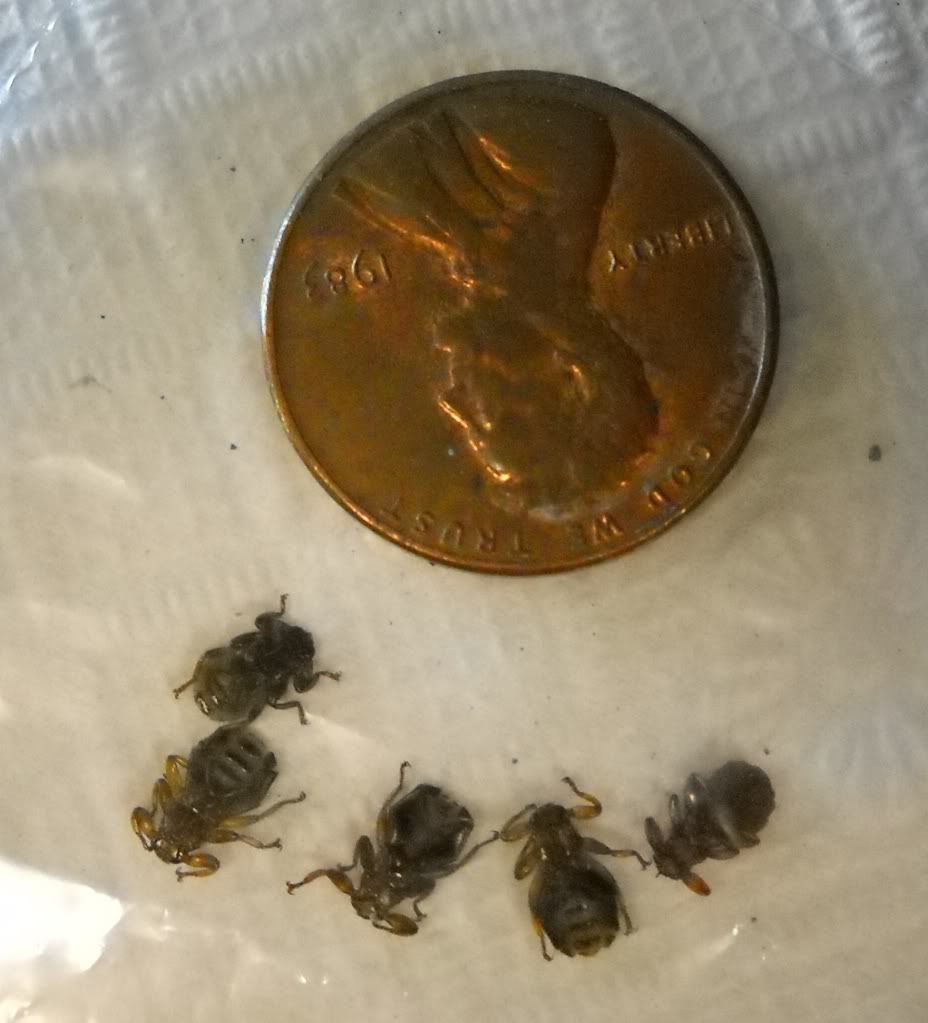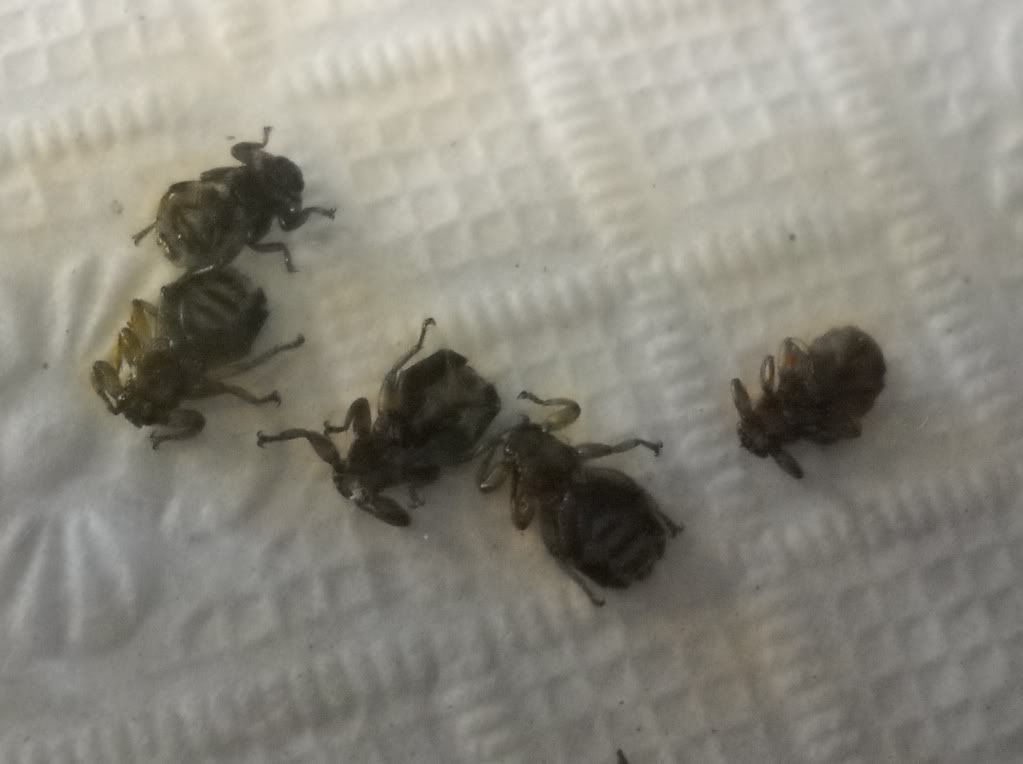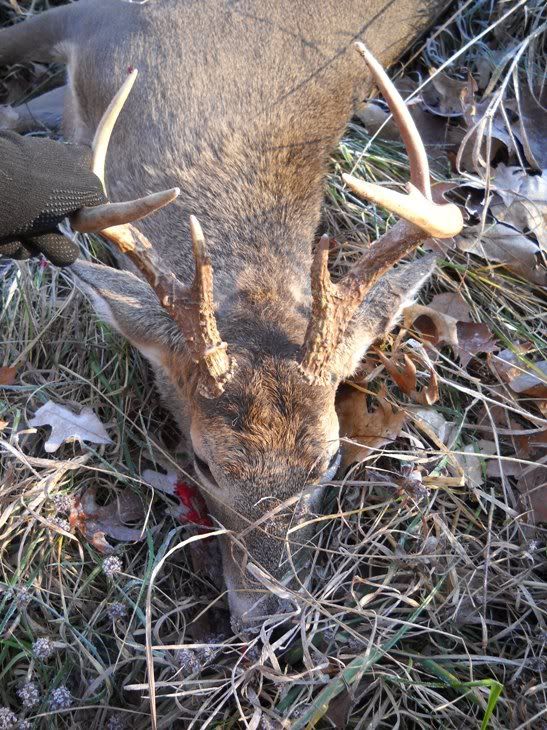
 |
Help me identify these bugs my PA deer was covered in, parasitic?
My Pennsylvania deer was covered in these things. They are about the size as a normal wood tick, but they have 3 distinct sections, not one like a tick, they have 6 legs instead of 8, they have a striped pattern on their back, and they're armored like a tick, very tough. They were dug in on the deer like a tick, and 2 jumped on my dog Brady and were very hard to get off even though they had not bit him yet, they were faster than a tick and clung to his fur like all get out.
I have spent about 3 hours on the web trying to find out what it is and have had zero friggin luck. In all my years in the field I have never seen them. If anyone happens to be in college and has a good Entomology professor let me know your e-mail and I'll send the large pics to you to have him/her identify them. It came from Bedford County, PA.      |
They appear to be some type of Lice
JW............. |
I think I got a hit on another website I posted the question about.
http://en.wikipedia.org/wiki/Lipoptena_cervi Some sort of asian deer louse fly that sheds it's wings once it's on it's host, nasty. Lipoptena cervi, the deer ked or deer fly, is a species of biting fly in the family of louse flies, Hippoboscidae. These flies are commonly encountered in temperate areas of Europe, Siberia and Northern China. It has been introduced to North America.[2] They are parasites of elk, deer and other bovine animals, sucking blood and laying eggs in the fur of the host animals. L. cervi is relatively small, adults usually being 5–7 millimetres (0.20–0.28 in) in length and are brownish in colour. Their body is flat and elastic, making their removal difficult. L. cervi is a poor flier and can only fly for short distances. Once the insect reaches its target, it sheds its wings and starts burrowing through the fur. L. cervi can be a nuisance, but are generally harmless. They will not reproduce on any other host than deer. They will however bite humans, and the bites are said to be painful and may casue an allergic skin reaction. Initially the bite may be barely noticeable and leaves little or no trace. Within 3 days, the site develops into a hard, reddened welt. The accompanying itch is intense and typically lasts 14 to 20 days. Occasionally, an itch papule may persist for a year[3]. The main annoyance in humans is the inconvenience and unpleasantness of removing keds from hair and clothes. Horses have been attacked, with severe symptoms of colic as a result[4]. Dogs that are bitten may develop a moderate to severe dermatitis [4]. Findings in Finland have found that L. cervi can carry and spread the Bartonella bacterium Bartonella schoenbuchensis in Deer.[3] Remains of Lipoptena cervi have been found on Ötzi, the Stone Age mummy from the Schnalstal glacier in the Italian Tyrol Both males and females of Lipoptena cervi consume blood from their hosts, feeding lasts 15 to 25 minutes[3]. The female produces one larva at a time and retains the developing larva in her body until it is ready to pupate. The larva feeds on the secretions of a "milk gland" in the uterus of its mother. The female will give birth to one fully mature white pre-pupa. She may produce larvae for as long as 10 months. A newborn pre-pupa will immediately darken, form the puparium and begin to pupate pupae on the forest floor, or where the deer bedded. After pupation, the winged adult emerges from the puparium and flies in search of a host. Upon finding a host the adult fly wings breaks off and it is permanently associated with its host.[6] Hosts Red Deer, moose, roe Deer, fallow Deer and siberian Musk Deer Linn. In the United States it has acquired hosts such as elk, white-tailed deer and reindeer.[6][7]. There are stray records of bites on humans, dogs[10] and badger, and will occasionally commit to the wrong host.[9] |
I think I got a hit on another website I posted the question about.
http://en.wikipedia.org/wiki/Lipoptena_cervi Some sort of asian deer louse fly that sheds it's wings once it's on it's host, nasty. Lipoptena cervi, the deer ked or deer fly, is a species of biting fly in the family of louse flies, Hippoboscidae. These flies are commonly encountered in temperate areas of Europe, Siberia and Northern China. It has been introduced to North America.[2] They are parasites of elk, deer and other bovine animals, sucking blood and laying eggs in the fur of the host animals. L. cervi is relatively small, adults usually being 5–7 millimetres (0.20–0.28 in) in length and are brownish in colour. Their body is flat and elastic, making their removal difficult. L. cervi is a poor flier and can only fly for short distances. Once the insect reaches its target, it sheds its wings and starts burrowing through the fur. L. cervi can be a nuisance, but are generally harmless. They will not reproduce on any other host than deer. They will however bite humans, and the bites are said to be painful and may casue an allergic skin reaction. Initially the bite may be barely noticeable and leaves little or no trace. Within 3 days, the site develops into a hard, reddened welt. The accompanying itch is intense and typically lasts 14 to 20 days. Occasionally, an itch papule may persist for a year[3]. The main annoyance in humans is the inconvenience and unpleasantness of removing keds from hair and clothes. Horses have been attacked, with severe symptoms of colic as a result[4]. Dogs that are bitten may develop a moderate to severe dermatitis [4]. Findings in Finland have found that L. cervi can carry and spread the Bartonella bacterium Bartonella schoenbuchensis in Deer.[3] Remains of Lipoptena cervi have been found on Ötzi, the Stone Age mummy from the Schnalstal glacier in the Italian Tyrol Both males and females of Lipoptena cervi consume blood from their hosts, feeding lasts 15 to 25 minutes[3]. The female produces one larva at a time and retains the developing larva in her body until it is ready to pupate. The larva feeds on the secretions of a "milk gland" in the uterus of its mother. The female will give birth to one fully mature white pre-pupa. She may produce larvae for as long as 10 months. A newborn pre-pupa will immediately darken, form the puparium and begin to pupate pupae on the forest floor, or where the deer bedded. After pupation, the winged adult emerges from the puparium and flies in search of a host. Upon finding a host the adult fly wings breaks off and it is permanently associated with its host.[6] Hosts Red Deer, moose, roe Deer, fallow Deer and siberian Musk Deer Linn. In the United States it has acquired hosts such as elk, white-tailed deer and reindeer.[6][7]. There are stray records of bites on humans, dogs[10] and badger, and will occasionally commit to the wrong host.[9] |
they look like deer flies.
they usually burrow in though, but will come back out when the host dies..like a tick. hard to tell. |
I always thought those were called dog ticks.
|
They are called deer keds and don't carry lymes disease. I had a bunch of them on my deer this year.
|
we call them louse flies, all the deer i have seen dead so far in PA and NY have been loaded with them. i have seen them a few times in the past but nothing like this year.
|
First PA imports the damned stink bug that is inundating my area, now Deer Fly? Damn you PA!!!
|
They're called deer keds.
|
| All times are GMT -8. The time now is 11:03 AM. |
Copyright © 2024 MH Sub I, LLC dba Internet Brands. All rights reserved. Use of this site indicates your consent to the Terms of Use.